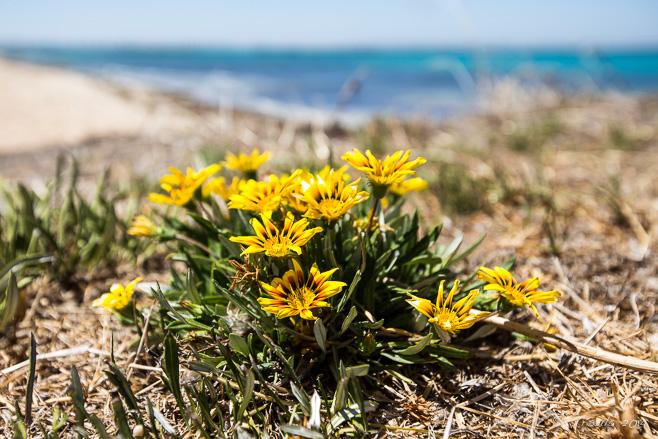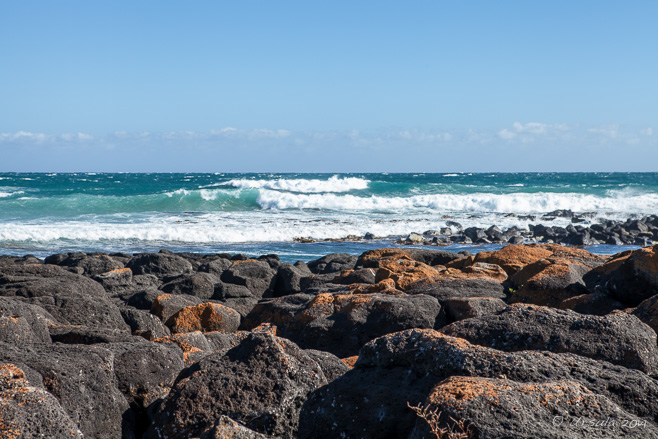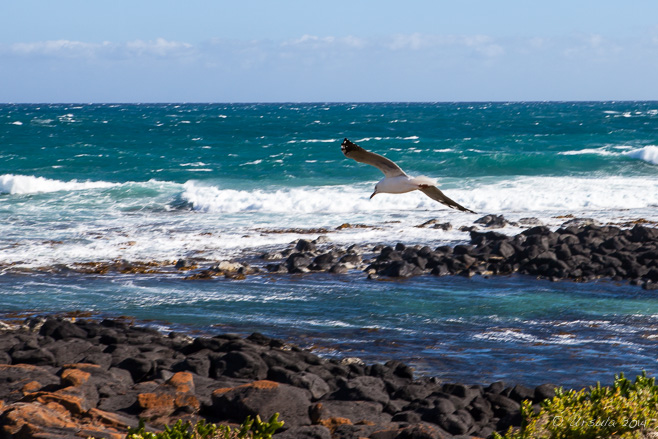
Simple Treasures
Yellow treasure flowers (Gazania rigens) bring cheery brightness into any day; they might be native to Africa, but they are perfectly at home in the sandy soils at the ocean’s edge in South Australia.
It is easy to hit over-load while travelling: too many wonderful sights, engaging activities, interesting people, and novel tastes and smells… This can be especially the case after spending time in an environment so sublime that it transports you, producing a nature-induced “peak experience”.
We had just driven the length of Australia’s Great Ocean Road, a drive through scenery so magnificent that it rates its own UNESCO World Heritage listing. Anything after that was bound to be anti-climactic!
But, we still had 620-720 kilometres – depending on the route we chose – to drive to Adelaide. So, with some trip-notes printed from the internet in hand, we took a deep breath, left the Great Ocean Road behind us, and pointed the car northwest.

South Beach and Pea Soup Cove, Port Fairy
The Great Ocean Road slipped away with no fanfare; by the time we reached the charming seaside town of Port Fairy, it was already half an hour behind us. Our first brief stop was for a breath of salt air overlooking the pounding turquoise waters.

Seagull, Port Fairy
It was late afternoon, with a tearing wind, as we watched the gulls swoop on the drafts.

Windmills
I couldn’t resist an iPhone snap out the window as we headed northwest across a golden rural landscape, replete with windmills. (iPhone 4S)

The Umpherston Sinkhole
Early next morning in Mount Gambier, South Australia’s second largest city, we took the time to explore some of the local attractions. Sitting on the side of the volcano of the same name, Mount Gambier boasts craters, sinkholes and caves. This one, the Umpherston Sinkhole, is a collapsed limestone cave that was first landscaped and planted by James Umpherston in 1886.

Sheoak (Casuarina) Overhead
The sinkhole garden is planted in layers, with trees overhead…

Young Grape Leaf
… foliage and flowers around the upper rim…

Ivy
… and thick curtains of ivy tumbling down the sides.

The Umpherston Sinkhole
The shadowed gardens at the bottom of the sinkhole include a fountain, slow-growing tree-ferns and colourful hydrangeas.

Blue Lake
One of Mount Gambier’s most popular attractions is Blue Lake, the extinct crater, filled with high-quality artesian drinking water. We were lucky: the colour of the lake changes with the seasons, being a steel grey in winter. Sometime in early November each year, it changes – almost overnight – to the spectacular cobalt blue we were treated to. Late February the colour gradually returns to its winter grey.

“Waawor”
The 3.6 kilometre walking circuit around Blue Lake – Waawor in the indigenous Boandik language – includes information signs and viewing points.

Blue Lake
Not yet noon, the day was already crackling with heat. Some of the foliage around the lake was clearly suffering from the recent dearth of rainfall and unusually high temperatures. The city of Mount Gambier can just be seen on the horizon.

Purple Flower
The hot, dry air hummed with insects and birdsong.

Flowering Trees
The hot air was also filled with the delicate scents of the native blooms.

Cactus Garden
A local group of cactus enthusiasts maintain a fenced and gated private garden of large cacti.

Rook Wall and Lookout
At the tail end of WWI, the Mount Gambier District Progress Association came up with a plan to do something for the town. Thanks to 1100 local volunteers (800 men and 300 women), in only one day the dolomite and limestone wall and lookout were predominantly finished. The feature was named for Mr. Arthur Rook, local publican and chair of the planning committee, who died prematurely from the Spanish flu in 1919.

The Pumping Station
The old Pumping Station, built from cream and pink dolomite in 1884, and extended in 1909, nestles across the Riddoch Highway from the Rook Wall.

Beachport Surf Beach
Our next stop was just east of the coastal town of Beachport to marvel at the colours and the expanse of empty beach.

Beachport Surf Beach
The surf beach, stretching in both directions, was almost deserted.

Beachport Jetty
Beachport is widely known for the long Beachport jetty; a steel screw pile jetty built between 1878-1882.

The Jetty
Originally 1220 meters long, the jetty still extends 772 meters into Rivoli Bay, making it visible on the horizon, even from a distance.

Whaling Monument
On the north side of Beachport is a cairn commemorating the area’s first white settlement: a whaling station established here in 1843.

Echidna
As we continued along the Southern Ports Highway, we had to stop the car to let a spiny anteater waddle across the road. I was prevented from taking a great shot by: 1) the speed at which the little creature moved, and 2) the searing heat of the pavement on my bare feet!

Customs House, Robe
The coastal town of Robe was declared an official port in 1847, shipping wool and receiving boatloads of Chinese immigrants heading to the Victorian goldfields. The Customs House was built in 1863 and was managed for many years by pioneering shipping agent George Omerod.

The Coorong
Our last, late afternoon stop before hitting the highways into Adelaide, was overlooking The Coorong: a string of saltwater lagoons at the mouth of the River Murray. Shielded from the Southern Ocean by the Younghusband Peninsula, the area has international importance as a wetland, as well as deep cultural significance to the local Ngarrindjeri people. It was hot – breathtakingly hot – and the brackish smell that spoke of salt-water organisms dying, was overwhelming.
 We could have spent days at each of our brief stops. What a fascinating, beautiful stretch of road, rich in scenery and history.
We could have spent days at each of our brief stops. What a fascinating, beautiful stretch of road, rich in scenery and history.
One day, we’ll be back – with the time to explore properly!
Until then,
Happy Travels!
Pictures: 04-05February2014





























.png)

